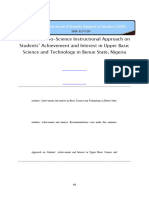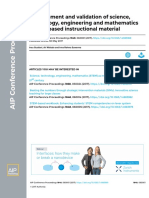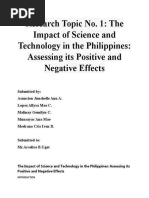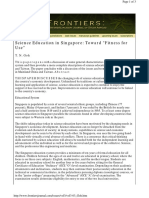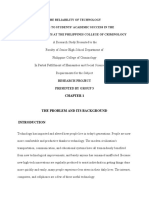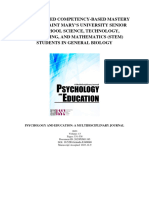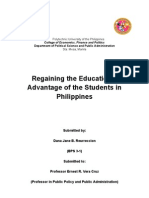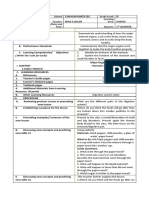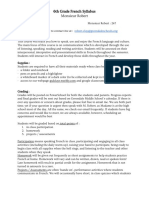0 ratings0% found this document useful (0 votes)
73 viewsChapter 1 Disertation
Chapter 1 Disertation
Uploaded by
Vince PrinceThis document introduces the importance of science and technology for national development and progress. It discusses the development of the science curriculum in the Philippines, which has been influenced by other countries. The document also notes that while the Philippines was once highly educated in Asia, its quality of education has been declining for decades according to various test scores. It identifies potential factors for the low achievement of Philippine students in science such as teacher qualifications, curriculum and instructional materials, and the teaching-learning process.
Copyright:
© All Rights Reserved
Available Formats
Download as DOCX, PDF, TXT or read online from Scribd
Chapter 1 Disertation
Chapter 1 Disertation
Uploaded by
Vince Prince0 ratings0% found this document useful (0 votes)
73 views2 pagesThis document introduces the importance of science and technology for national development and progress. It discusses the development of the science curriculum in the Philippines, which has been influenced by other countries. The document also notes that while the Philippines was once highly educated in Asia, its quality of education has been declining for decades according to various test scores. It identifies potential factors for the low achievement of Philippine students in science such as teacher qualifications, curriculum and instructional materials, and the teaching-learning process.
Original Description:
sample notes
Copyright
© © All Rights Reserved
Available Formats
DOCX, PDF, TXT or read online from Scribd
Share this document
Did you find this document useful?
Is this content inappropriate?
This document introduces the importance of science and technology for national development and progress. It discusses the development of the science curriculum in the Philippines, which has been influenced by other countries. The document also notes that while the Philippines was once highly educated in Asia, its quality of education has been declining for decades according to various test scores. It identifies potential factors for the low achievement of Philippine students in science such as teacher qualifications, curriculum and instructional materials, and the teaching-learning process.
Copyright:
© All Rights Reserved
Available Formats
Download as DOCX, PDF, TXT or read online from Scribd
Download as docx, pdf, or txt
0 ratings0% found this document useful (0 votes)
73 views2 pagesChapter 1 Disertation
Chapter 1 Disertation
Uploaded by
Vince PrinceThis document introduces the importance of science and technology for national development and progress. It discusses the development of the science curriculum in the Philippines, which has been influenced by other countries. The document also notes that while the Philippines was once highly educated in Asia, its quality of education has been declining for decades according to various test scores. It identifies potential factors for the low achievement of Philippine students in science such as teacher qualifications, curriculum and instructional materials, and the teaching-learning process.
Copyright:
© All Rights Reserved
Available Formats
Download as DOCX, PDF, TXT or read online from Scribd
Download as docx, pdf, or txt
You are on page 1of 2
Chapter 1
THE PROBLEM AND THE RELATED LITERATURE
INTRODUCTION
"In this changing world, math and science is paramount."
(U.S. Department of Education, 2006. Undoubtedly, we live in a
competitive world. The importance of Science and technology is
overwhelming and that, its applications have transformed the
society through dramatic advances in almost fields including
medicine, engineering, electronics, research and development,
and in more recent times, dramatic leaps in computer technology
to modern digital e-learning technology.
The role of science and technology has become a key
component of modern technology. As it was cited by Cuyegkeng and
Dayrit (in their research retrieved 2012) no modern state can
achieve or maintain prosperity without science and technology.
It also determines part of socio-economic progress of the
country. In the draft orientation paper of the Physics Research
People (retrieved last April, 2012), the national progress is
highly correlated to the capacity of a country to produce local
industrial goods for domestic needs and that industrialization
is very much dependent on the capacity of a country to use
science and technology to process locally found raw materials
into high-tech products and life must gear itself to keep
abreast to the challenges brought by global competitiveness by
harnessing their scientific capabilities and skills through
education. this is aim was also stated in the 1987 Philippine
Constitution, Article XIV section 10. to wit:
Science and technology is very essential for national
development and progress. Hence, the state shall give priority
to research and development, invention, innovation, and the
utilization and to science and technology education and other
trainings or services related to science and technology. It
shall support indigenous, appropriate and self-reliant
scientific and technological capabilities and their application
to the country's productive systems and national life.
In the Philippines, the development of science curriculum
has been largely influenced by developments in foreign countries
like United States, United Kingdom, Australia and Japan (lbe and
Ogena, 1998). New ways for teaching such as discovery and
inquiry approaches came about in the late '70s. As years passed,
the science education curriculum has been reformed towards
providing greater opportunities for students to realize that
principles studied in class are relevant to daily life, the
present curriculum which include the BEC, 2010 SEC, and K-12
program integrate local and relevant technologies and their
environmental impact with science concept. Value formation in
the context of scientific and technological activities is
included whenever possible (Tan, 2007). The different curriculum
can be summarized as learner-centered, multidisciplinary,
interdisciplinary, and issue/project/problem/process-based.
these different approaches are based on sound learning theories
principles.
According to the human capital theory, the economic
development of a nation is a function of the quality of its
education. In other words: the greater and better educated the
people will mean a greater the chance of economic development.
There was a time when Filipinos were the best educated in Asia,
the nation's primary, secondary and tertiary educational
institutions were widely respected. However, official data shows
that Philippine's quality of education has been declining for
decades (Gale, 2011). The results of National Achievement Test
(NAT) conducted among elementary and high school students as
well as in the NCAE and board exams for college students were
below the target mean score. Further, the Third International
Mathematics and Science Study (TIMMS)was administered to our
students in 4th and 8th grade levels on 1999 and 2003. The TIMMs
was participated by over 50 countries. the result of the 2003
TIMMS revealed that Philippine TIMMS Second year students scored
378 in math and 377 in science which falls under the low
benchmarks of 400 established by TIMMS. The Philippines Second
year students ranked 41st in Math and 42nd in science among 45
countries.
In the 2012-2011 Global competitiveness report of the world
economic forum, the Philippines raked 69th in educational
system, 112th in science and math and 76th in internet access.
What are the factors to consider in getting low achievement
of our students in science? The quality of education acquired by
the students depends largely on the teachers: their
qualifications and competencies in delivering quality
educational services; the school curriculum and instructional
materials and the teaching-learning process. These factors have
been cited as causes of the current state of science education
(lbe and Ogena, 1998) These factors are foci of this paper.
You might also like
- Certificate of Full PaymentDocument2 pagesCertificate of Full PaymentVince Prince64% (14)
- Current Trends in Science Education in The PhilippinesDocument12 pagesCurrent Trends in Science Education in The PhilippinesMelindaSuitosColobong-Garpida100% (10)
- Ebun ProjectDocument31 pagesEbun Projectunaezechukwuamaka1994No ratings yet
- SantiagoDocument35 pagesSantiagoVince PrinceNo ratings yet
- Placement2 - Details - 1645091806 - IBS Placement 2022Document6 pagesPlacement2 - Details - 1645091806 - IBS Placement 2022Divya ShindeNo ratings yet
- Arrest of Wanted PersonsDocument13 pagesArrest of Wanted PersonsVince Prince100% (1)
- Soppb Form 2013-02 Revised Soppd Application Form For Key PositionsDocument2 pagesSoppb Form 2013-02 Revised Soppd Application Form For Key PositionsVince PrinceNo ratings yet
- (TEMPLATE 1) Letterhead To Be Used For Letters To Other Agencies and Memo For NHQDocument1 page(TEMPLATE 1) Letterhead To Be Used For Letters To Other Agencies and Memo For NHQVince PrinceNo ratings yet
- Group Assignment 1 Case Study 1: Assigning Students To SchoolsDocument1 pageGroup Assignment 1 Case Study 1: Assigning Students To SchoolsLINH LE THUYNo ratings yet
- Current Trends in Science Education in The Philippines1Document11 pagesCurrent Trends in Science Education in The Philippines1MelindaSuitosColobong-Garpida100% (1)
- Ej 1327860Document24 pagesEj 1327860lisayaaaah0327No ratings yet
- Instructional Materials Development - A Worktext in Science, Technology and Society PDFDocument25 pagesInstructional Materials Development - A Worktext in Science, Technology and Society PDFJhomari Valdez100% (1)
- Module 6 Science Education in The PhilippinesDocument4 pagesModule 6 Science Education in The Philippineswolfey cloudNo ratings yet
- The Effect of Computer-Aided Lesson On The Performance of High School Sophomore Students in Selected Topics BiologyDocument15 pagesThe Effect of Computer-Aided Lesson On The Performance of High School Sophomore Students in Selected Topics BiologyPsychology and Education: A Multidisciplinary JournalNo ratings yet
- GEED 10083 Science, Technology, and Society: General Concepts and Historical EventsDocument6 pagesGEED 10083 Science, Technology, and Society: General Concepts and Historical EventsShane Penuliar0% (1)
- Development and Validation of Flipbook in Earth and Life ScienceDocument7 pagesDevelopment and Validation of Flipbook in Earth and Life ScienceIOER International Multidisciplinary Research Journal ( IIMRJ)No ratings yet
- Final Concept Paper For PrintDocument16 pagesFinal Concept Paper For PrintSabnahis Batongbuhay ExtensionNo ratings yet
- Determination of Science Literacy Levels of The Classroom Teachers (A Case of Mu ÷la City in Turkey)Document8 pagesDetermination of Science Literacy Levels of The Classroom Teachers (A Case of Mu ÷la City in Turkey)Melisa AsniatiNo ratings yet
- Qualitative Research 2.3Document8 pagesQualitative Research 2.3Neil MirandaNo ratings yet
- Chapter 1 3 E.PDocument46 pagesChapter 1 3 E.PKhristine Khate Odiaman MendezNo ratings yet
- Insight Paper - Lei NateDocument11 pagesInsight Paper - Lei NateLei Nate?No ratings yet
- Chapter 1Document16 pagesChapter 1Jayson Dotimas VelascoNo ratings yet
- Laro NG Lahi Thru Based ActivitiesDocument14 pagesLaro NG Lahi Thru Based ActivitiesGlen Lluz100% (1)
- vol.,-10(1)-okwara---upuDocument10 pagesvol.,-10(1)-okwara---upujihannitaNo ratings yet
- Nation BuildingDocument4 pagesNation Buildingunicuss18No ratings yet
- International l-WPS OfficeDocument5 pagesInternational l-WPS OfficeglechershemerryNo ratings yet
- Development and Validation of Science, Technology, Engineering and Mathematics (STEM) Based Instructional MaterialDocument8 pagesDevelopment and Validation of Science, Technology, Engineering and Mathematics (STEM) Based Instructional MaterialnikeastiswijayaNo ratings yet
- CurriDocument14 pagesCurrichika AaronNo ratings yet
- EFFECTIVENESS OF 4as ACTIVITY ANALYSIS ADocument45 pagesEFFECTIVENESS OF 4as ACTIVITY ANALYSIS Asanjosenighthighschool taclobancity100% (1)
- Basic and Integrated Science Process Skills Acquisition and Science Achievement of Seventh-Grade LearnersDocument15 pagesBasic and Integrated Science Process Skills Acquisition and Science Achievement of Seventh-Grade LearnersLeon AipTelNo ratings yet
- The Impact of Science and Technology in The Philippines StsDocument9 pagesThe Impact of Science and Technology in The Philippines StsJay Dee RiñonNo ratings yet
- Problem-Based Learning in Developing Scientific Literacy in Senior High School StudentsDocument10 pagesProblem-Based Learning in Developing Scientific Literacy in Senior High School StudentsLUCY NGOHONo ratings yet
- Trends and Perspectives of Information Technology Development in The Philippines: A Review of Filipino-Chinese SchoolsDocument9 pagesTrends and Perspectives of Information Technology Development in The Philippines: A Review of Filipino-Chinese SchoolsRoxanne Mae VillacoraNo ratings yet
- Magdalenes FriendDocument67 pagesMagdalenes FriendJOSHUA ADINOYI VICTORNo ratings yet
- Research Inventy: International Journal of Engineering and ScienceDocument5 pagesResearch Inventy: International Journal of Engineering and ScienceinventyNo ratings yet
- Ijisser M 3 2024Document10 pagesIjisser M 3 2024Mynaijakings TVNo ratings yet
- SPEC 111A Proposal TemplateDocument12 pagesSPEC 111A Proposal TemplateCarlo DugeniaNo ratings yet
- Singapore SC EducationDocument3 pagesSingapore SC Educationfaizsuria7No ratings yet
- Ritz - Fan - 2014 - Int J Tecnol Des EducDocument23 pagesRitz - Fan - 2014 - Int J Tecnol Des EducPatrícia MoreiraNo ratings yet
- 892 3053 1 SMDocument13 pages892 3053 1 SMRajakumaranNo ratings yet
- Reviewer For MidtermsDocument5 pagesReviewer For MidtermsSherwin VillanuevaNo ratings yet
- Localization and Contextualization of SCDocument12 pagesLocalization and Contextualization of SCPaul Mark DizonNo ratings yet
- Generative and Predict-Observe-Explain Instructional Strategies: Towards Enhancing Basic Science Practical Skills of Lower Primary School PupilsDocument7 pagesGenerative and Predict-Observe-Explain Instructional Strategies: Towards Enhancing Basic Science Practical Skills of Lower Primary School PupilsrisnaNo ratings yet
- Some Imperatives of ICT Integration in The Philippine Educational SystemDocument15 pagesSome Imperatives of ICT Integration in The Philippine Educational Systemstclementacademyinc1No ratings yet
- Exam STsDocument6 pagesExam STsMADELO VENUSNo ratings yet
- May ResearchDocument29 pagesMay ResearchRicka MhaeyNo ratings yet
- Brain-Based Learning in Physics of Grade 7 Students: International Journal For Multidisciplinary ResearchDocument21 pagesBrain-Based Learning in Physics of Grade 7 Students: International Journal For Multidisciplinary Researchdannarose876No ratings yet
- Activity Preferences of Generation Z Students For Tertiary Physical Education: Implications For Curriculum EnhancementDocument15 pagesActivity Preferences of Generation Z Students For Tertiary Physical Education: Implications For Curriculum EnhancementRuben Lagunero Tagare JrNo ratings yet
- Teaching and Learning With Technology inDocument17 pagesTeaching and Learning With Technology inJenard ManceraNo ratings yet
- Implementation Issues in Science EducationDocument6 pagesImplementation Issues in Science Educationomorostephen93No ratings yet
- RANCES-action researchDocument18 pagesRANCES-action researchRey Mark Bagalacsa LagdaanNo ratings yet
- Scientific Literacy MAGBATADocument7 pagesScientific Literacy MAGBATAJC MagbataNo ratings yet
- Direction: Answer The Following Questions:: ActivityDocument1 pageDirection: Answer The Following Questions:: ActivityKhristian Jan Andrei GarciaNo ratings yet
- 11.a Correlational Analysis of Students Achievement in Waec and Neco MathematicsDocument15 pages11.a Correlational Analysis of Students Achievement in Waec and Neco MathematicsAlexander Decker100% (1)
- Teaching Biology With Technology Using Some Selected Topics in Senior Secondary School in Gwagwalada Area Council, AbujaDocument74 pagesTeaching Biology With Technology Using Some Selected Topics in Senior Secondary School in Gwagwalada Area Council, AbujaMASTER CRAFTNo ratings yet
- RES5Document2 pagesRES5waltz crisNo ratings yet
- The Reliability of Technology Relating To Students' Academic Success in The Grade 12 Students at The Philippines College of CriminologyDocument22 pagesThe Reliability of Technology Relating To Students' Academic Success in The Grade 12 Students at The Philippines College of CriminologyJaika BeatrixNo ratings yet
- Mathematics Performance of Students in A Philippine State University 7859Document14 pagesMathematics Performance of Students in A Philippine State University 7859Ingrid VillaflorNo ratings yet
- The ProblemDocument5 pagesThe ProblemMae EtcubañasNo ratings yet
- Aunty Maduka OriginalDocument53 pagesAunty Maduka Originalonwuachu.iheanyiNo ratings yet
- CH 3 Lesson 2 - UpdatedDocument3 pagesCH 3 Lesson 2 - UpdatedFreda Buking DayogNo ratings yet
- The Perceived Competency-Based Mastery Level of Saint Mary's University Senior High School Science, Technology, Engineering, and Mathematics (STEM) Students in General BiologyDocument9 pagesThe Perceived Competency-Based Mastery Level of Saint Mary's University Senior High School Science, Technology, Engineering, and Mathematics (STEM) Students in General BiologyPsychology and Education: A Multidisciplinary JournalNo ratings yet
- Scientific and Technological Skills Acquisition at The Primary School Level As A Strategy To Mitigating The Challenges of Vision 2020 in NigeriaDocument16 pagesScientific and Technological Skills Acquisition at The Primary School Level As A Strategy To Mitigating The Challenges of Vision 2020 in Nigeriathe_sinnerNo ratings yet
- Regaining The Educational Advantage of The Students in PhilippinesDocument15 pagesRegaining The Educational Advantage of The Students in PhilippinesDana Jane B. ResurreccionNo ratings yet
- E-Learning Readiness and Its Correlates Among Secondary School Teachers in Nablus, PalestineDocument6 pagesE-Learning Readiness and Its Correlates Among Secondary School Teachers in Nablus, PalestineSIT ADAWIAHNo ratings yet
- 1 MODERN TECHNOLOGY AS INSTRUCTIONAL DEVICES M Tesis Menzy 02-25-16 4 PMDocument91 pages1 MODERN TECHNOLOGY AS INSTRUCTIONAL DEVICES M Tesis Menzy 02-25-16 4 PMRowena BalabagnoNo ratings yet
- To Die For God-Such Is My Will.Document3 pagesTo Die For God-Such Is My Will.Vince PrinceNo ratings yet
- Dental Mission Object Class Particular Quantity Unit Cost AmountDocument1 pageDental Mission Object Class Particular Quantity Unit Cost AmountVince PrinceNo ratings yet
- Description of A Perfect MotherDocument1 pageDescription of A Perfect MotherVince PrinceNo ratings yet
- Workbook Activity CycleDocument3 pagesWorkbook Activity CycleVince PrinceNo ratings yet
- Authorization Letter JLC FilesDocument2 pagesAuthorization Letter JLC FilesVince PrinceNo ratings yet
- Parameter 7 RidDocument3 pagesParameter 7 RidVince Prince0% (1)
- Blood Letting Object Class Particular Quantity: Snacks (AM) 50 Lunch 10 POL 10Document2 pagesBlood Letting Object Class Particular Quantity: Snacks (AM) 50 Lunch 10 POL 10Vince PrinceNo ratings yet
- Communications and Electronics Service Regional Communications and Electronics Office O2Document7 pagesCommunications and Electronics Service Regional Communications and Electronics Office O2Vince PrinceNo ratings yet
- RHQDocument4 pagesRHQVince PrinceNo ratings yet
- Certification From PNP Lower UnitsDocument1 pageCertification From PNP Lower UnitsVince PrinceNo ratings yet
- Notice of Meeting: Communications and Electronics Service Regional Communications and Electronics Office 2Document1 pageNotice of Meeting: Communications and Electronics Service Regional Communications and Electronics Office 2Vince PrinceNo ratings yet
- January 16-30, 2018 Accomplishment On Red Teaming OperationsDocument16 pagesJanuary 16-30, 2018 Accomplishment On Red Teaming OperationsVince Prince100% (1)
- Regional Communications and Electronics Office 02Document1 pageRegional Communications and Electronics Office 02Vince PrinceNo ratings yet
- Format CPNP Directive On Focus January 28 2018Document8 pagesFormat CPNP Directive On Focus January 28 2018Vince PrinceNo ratings yet
- Memo To Lower New - MahindraDocument2 pagesMemo To Lower New - MahindraVince PrinceNo ratings yet
- From: 250600H February T0 260600H February 2017Document3 pagesFrom: 250600H February T0 260600H February 2017Vince PrinceNo ratings yet
- January 1-15, 2018 Accomplishment On Red Teaming OperationsDocument16 pagesJanuary 1-15, 2018 Accomplishment On Red Teaming OperationsVince Prince100% (3)
- Sitrep On Drugs July 15, 2016 (9 PM)Document1 pageSitrep On Drugs July 15, 2016 (9 PM)Vince PrinceNo ratings yet
- PRO2 ROPD CMC 50/2017 (All Saints' and Souls' Day 2017) : Office/Unit Rank/Name DateDocument1 pagePRO2 ROPD CMC 50/2017 (All Saints' and Souls' Day 2017) : Office/Unit Rank/Name DateVince PrinceNo ratings yet
- Parameter 7 RidDocument17 pagesParameter 7 RidVince PrinceNo ratings yet
- CS408 Finalterm Solved MCQs With Reference by Miss KazmiDocument20 pagesCS408 Finalterm Solved MCQs With Reference by Miss Kazmihowtoplaygames38No ratings yet
- Effective Time ManagementDocument7 pagesEffective Time ManagementNehaNo ratings yet
- Robertsonetal 2022Document15 pagesRobertsonetal 2022Vassos KoutsioundasNo ratings yet
- Lesson Plan Practical English Restaurant ProblemsDocument2 pagesLesson Plan Practical English Restaurant ProblemsRoberth RamirezNo ratings yet
- Pedagogical Handout Research Methodology Dr Khedidja HAMMOUDIDocument133 pagesPedagogical Handout Research Methodology Dr Khedidja HAMMOUDIKADAMORONo ratings yet
- Ss CTC AmetekDocument8 pagesSs CTC AmetekRamses CanoNo ratings yet
- Healthcare Technologist in Public HealthDocument28 pagesHealthcare Technologist in Public HealthNeelesh Bhandari100% (2)
- CVDocument1 pageCVTANVEER AHMEDNo ratings yet
- Tioc Method RDLDocument3 pagesTioc Method RDLGweneth WajeNo ratings yet
- Front Pages - MCA - Major ProjectsDocument6 pagesFront Pages - MCA - Major ProjectsSHUBHAM YADAVNo ratings yet
- Cot LESSON-PLAN ScienceDocument3 pagesCot LESSON-PLAN ScienceEvelyn86% (7)
- A Beautiful Place to Get LostDocument200 pagesA Beautiful Place to Get LostShantanu Keshewad60% (5)
- 1 200 Items Prof Ed Exam Drill PDFDocument17 pages1 200 Items Prof Ed Exam Drill PDFScribdNo ratings yet
- 1 & 3 Generation UniversityDocument10 pages1 & 3 Generation UniversityEriye OgbokeNo ratings yet
- Brochure Cambridge BA 300620Document15 pagesBrochure Cambridge BA 300620ghotamaNo ratings yet
- Assignment 6 CTEDocument6 pagesAssignment 6 CTEMarina KennedyNo ratings yet
- Nih DiseasesDocument165 pagesNih DiseasesDon Dadal DilidiliNo ratings yet
- Reaction On Russell's The Value of PhilosophyDocument1 pageReaction On Russell's The Value of PhilosophyGilbeys TangcawanNo ratings yet
- Empire MTDocument74 pagesEmpire MTDon BroesuNo ratings yet
- Elegant Wire and Bead Crochet Jewelry 649919Document6 pagesElegant Wire and Bead Crochet Jewelry 649919Wilma Gonzalez0% (3)
- Dell OpenManage With Microsoft Windows Server 2012Document26 pagesDell OpenManage With Microsoft Windows Server 2012Rus CosminNo ratings yet
- System Development Life Cycle-NotesDocument35 pagesSystem Development Life Cycle-NotesManish ChaturvediNo ratings yet
- Unicorn Report 2023 - v7Document175 pagesUnicorn Report 2023 - v7EmmyNo ratings yet
- Texto A Tiktok, A Social Media SensationDocument2 pagesTexto A Tiktok, A Social Media SensationLaura Gompa100% (1)
- French Syllabus 6th GradeDocument3 pagesFrench Syllabus 6th Gradeapi-471703523No ratings yet
- Resume Writing: Step by Step Approach by Fran Moga SBA Career ServicesDocument16 pagesResume Writing: Step by Step Approach by Fran Moga SBA Career Servicesashish2scribdNo ratings yet
- Co Ordinated Sciences Double Award 9 1 0973 June 2023 Grade Threshold TableDocument1 pageCo Ordinated Sciences Double Award 9 1 0973 June 2023 Grade Threshold Tablet.dyakivNo ratings yet
- Economics 181 International Trade HomeworkDocument6 pagesEconomics 181 International Trade Homeworkwxvhtrgkf100% (1)























